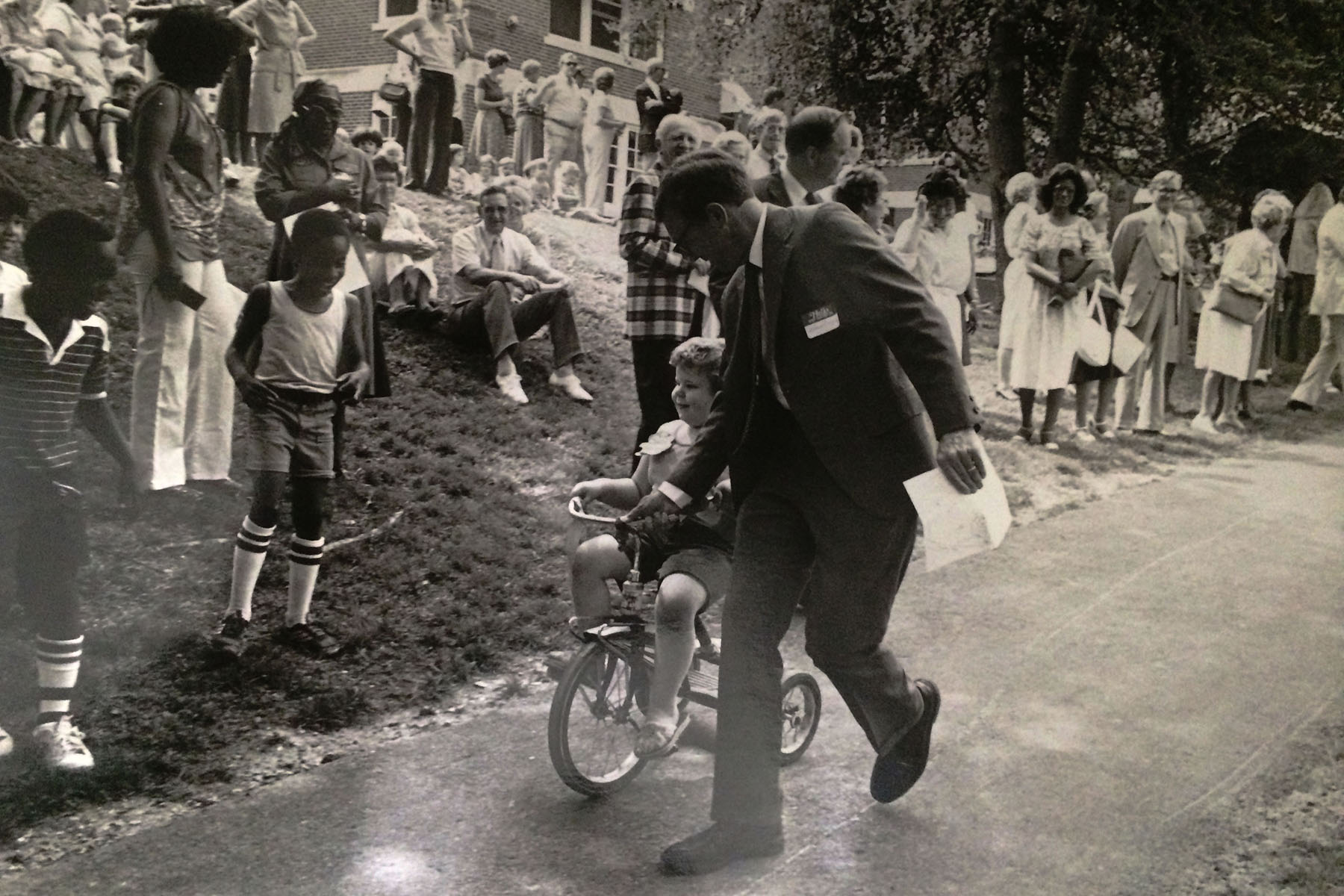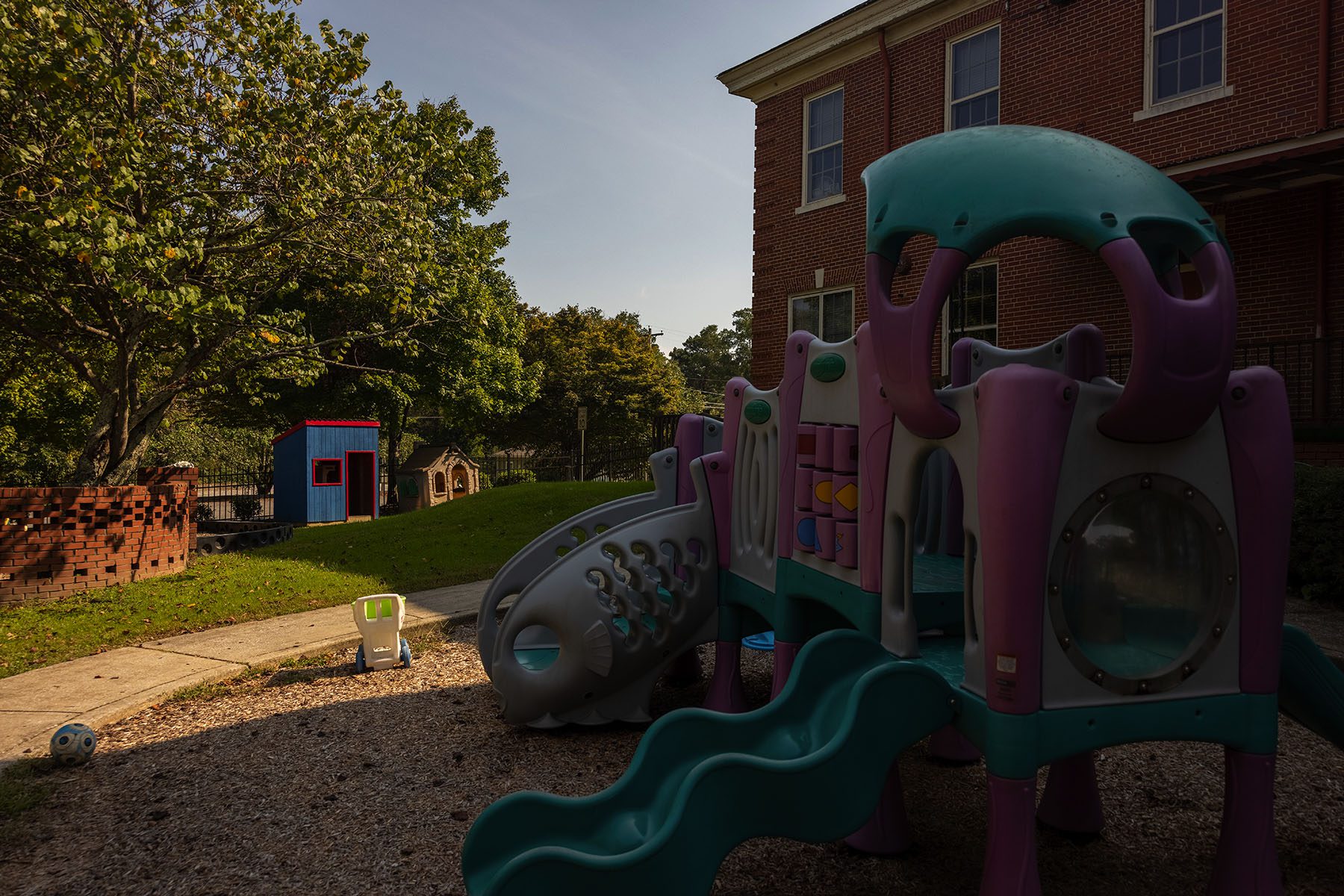This story was supported by the Solutions Journalism Network, a nonprofit organization dedicated to rigorous and compelling reporting about responses to social problems.
Over the past 150 years, a daycare center in Chattanooga, Tennessee, has done something exceptionally rare in the child care industry: Not only has it stayed open, but it has kept growing.
When it first opened in 1872, the Chambliss Center for Children was a home for orphaned kids, later becoming a space for children transitioning into foster care. In the 1970s, it opened the area’s first 24-hour daycare as working mothers entered the labor force in larger numbers. By the 1980s, it was running the finances for a handful of other day care centers, too. And in the early 2000s, it was operating a dozen child care programs for the children of teachers. Today, it does nearly all of those things at once.
Chambliss has become something of a model across the country for what local child care could look like as others race to just survive, like “mice on a treadmill,” said Louise Stoney, an expert in early care and education finance and policy.
“The basic business model of child care on which all of our rules were built, on which our system was built, doesn’t work,” Stoney said.
Chambliss was one of the first to break that model, she said, and in recent years, more and more centers have tried a similar approach — one that focuses on the business side of child care as much as the care itself.

For decades, the fatal flaw at the center of child care has been the number of people it has to employ. Classrooms are required by state law to have a certain number of adults per child, and those ratios get smaller for younger kids. In Tennessee, there must be one adult for every four infants, and one for every seven 2-year-olds. Adding more kids (and revenue) requires adding more teachers, who can only be paid little more than minimum wage — even the exorbitant costs of child care are not enough to cover such large staffing needs.
Nearly all of those workers — 95 percent — are women and a third are people of color, who are earning some of the lowest wages in the nation. The median hourly pay for a child care worker in the United States is $12.24, leading more than 15 percent of child care workers to live below the poverty line in 41 states, according to a recent report from the Treasury Department. The majority also rely on public assistance and few can afford to put their own children in the centers where they work because the cost of care for parents is so high, it eats up about 13 percent of the income for most families — about twice what is deemed affordable. Almost 20 percent of children under the age of 5 are being cared for by a single mother, a share that has been rising over time.
To make that sustainable for a child care center, someone needs to be keeping a close eye on payroll and expenses while applying for every scrap of grant money that could keep the center going. But few agencies can afford to pay someone to do that, and center directors, who are typically early childhood experts, not business people, are usually spread thin.
That’s where Chambliss is different, said Katie Harbison, the center’s president. At Chambliss’s main campus, experts run the finances, payroll, grant applications, budgets, human resources and other business-side particulars for its six off-site centers, which have their own directors and staff, on a contract basis.
The finances are outsourced and consolidated, and the directors are freed up to focus on care.
Another perk: If one center is struggling, Chambliss lends them the money. Sometimes they pay it back, sometimes they don’t. But they stay open. They survive. When Chambliss applies for funding or other aid, it does so in the name of all the child care centers it’s helping to support. The nonprofit has a more than $6 million budget that includes donations, an endowment and two thrift stores that generate revenue.
“If an agency is struggling, it’s like our arm is struggling. They are us and we are them in many different ways,” Harbison said. “If you’re a standalone agency and you have a bad year, it might put you under or you might be dead in the water.”

The proposition for a mission-based nonprofit like Chambliss is that it can continue to keep more kids in child care — about 750 children, predominantly from low-wage families, are served by their centers. It’s also a way to support parents. Chambliss expanded into 24-hour care as a way to help low-income parents working nontraditional hours. It continues that legacy of trying to make child care affordable for low-income parents by operating two thrift stores where the proceeds go to help subsidize care and offering a sliding scale of cost at the centers, depending on how much parents earn.
JoAnn Walker, a nurse in Chattanooga, said she had to pull her eldest daughter out of a different day care when she was a baby because the cost was too high. Walker had to switch to working night shifts just so she could watch her daughter, now 17, during the day.
“I was paying more in daycare than I was paying in rent,” Walker said.
When she had her two youngest kids, she was able to get a spot for them at Chambliss.
Walker now pays $112 a week for both her 2-year-old daughter and 1-year-old son at Chambliss. The average weekly cost of child care for infants in Tennessee is about $700 — per child.
Shifting the way centers do business could help secure the future of the child care industry at a time when it is barely holding on. One in three child care workers lost their jobs at the start of last year as the industry collapsed under the weight of increased costs brought on by the pandemic and nonexistent retention. Many centers, including Chambliss, are still struggling to attract workers.
The blow from the pandemic is so severe that the United States is considering a $450 billion investment in child care and universal pre-K for the first time in the nation’s history. The second half of the solution lies there, in ensuring that potential investment turns into sustained federal subsidy, experts say. According to a recent report from the Treasury Department, the United States invests fewer public dollars in early childhood education and care than almost all developed countries.
“It isn’t just money. We have to give more money and build a system that can be sustainable,” Stoney said.
The shared service model could be the answer. Chambliss and its six off-site centers have endured decades of headwinds, which haven’t always meant roaring success and soaring profits. But they were all able to remain open during the pandemic.
Greg Cullum, who serves as treasurer on Chambliss’s board, said “there is never enough money to fulfill the need” for child care. Chambliss’s endowment and deep connections in the community help it pick up donations year to year, but it rarely ends the year in a surplus. This year so far, Chambliss still has a funding gap of about $150,000 it needs to raise for an expansion that is underway on its main campus.
So it’s not a silver bullet, Cullum said, but it’s working.
“It’s not gonna make a poorly-run operation successful, but it can make one that’s marginally viable, I think, viable,” he said. “There is probably more need for their shared services than we can provide.”
Over the years, the Chambliss model has been used as an example for other centers looking to try a different approach, and in the past decade, more have signed on to try it in their own communities. Diane Price first listened to a presentation Stoney gave in Denver about the shared service child care model — Chambliss’s model — about a decade ago and was sold on the spot.
“I remember literally standing up from the table, leaning against a wall and just banging my head against the wall saying, ‘That makes so much sense, what have I been missing all these years?’” said Price, who is the president and CEO of Early Connections Learning Centers in Colorado Springs, a child care center that has been operating since 1897.
Price said that the center had never viewed itself as a business. They were teachers, social workers, people who wanted to work with children. But freeing up the center directors to focus on just the child care could lead to better outcomes for the agencies and the kids.
“We hire directors for their knowledge in child growth and development and early care and education, and then we ask them to move into a position that is all the kinds of things that we weren’t looking for when we hired them. We’re saying, ‘Do you know how to make a budget? How to negotiate insurance, negotiate a contract?’” Price said. “You can’t be a generalist in all these areas.”

In 2008, Price started to try out the shared service model. Directors at Early Connections’ six centers stopped collecting fees from parents and a finance person was brought in to handle the payments.
Revenue went up $20,000 in the first month alone.
That core administrative structure has grown in the years since, adding a centralized enrollment department and a human resources department that is focused on recruitment, retention and compensation for teachers, which is critical in an industry where payroll is the largest expense.
Like Chambliss, Early Connections is doing a little bit of everything. It also runs an in-house child care center for parents visiting the area’s Fourth Judicial District Court and Colorado Springs Municipal Court and it has classrooms in two schools. One of its sites is tripling in size this fall, and another center is expanding.
More recently, entire businesses have opened strictly to run the financial needs of child care centers.
A few years ago, a couple of early childhood experts in Wisconsin started considering what it might be like to set up a shared-services child care network for the entire state. They talked to Chambliss and some of the centers set up in a similar model and used them as templates to start the Wisconsin Early Education Shared Services Network in 2019. The network, which has dedicated coaches that help the centers craft individual business goals and offers a pool of substitute teachers to fill staffing needs, is already serving 135 child care programs in 11 counties.The back office staff runs billing and receiving, and offers a management software for the agencies that keeps track of particulars as granular as when a staff member is due for an immunization or to renew CPR training. The service is tiered, depending on how much centers want or need.
Paula Drew, the co-director for the network and a former executive director of a nonprofit preschool and after-school program, said the program helps to establish center directors as business people — in addition to their credentials in early learning.
“Ninety-nine percent of them are women, and sometimes they’ll say, ‘I’ll have to ask my husband about that,’ or ‘I’m not sure if we have enough money in the bank,’” Drew said. “We just help them come to this place of, as a small business, you are the one making the decisions. You need to have a budget … and that gives you the freedom to know what you have to spend.”
They’ve seen results. Only about 1 percent of the programs they work with closed during the pandemic — statewide in Wisconsin between 5 and 10 percent of all child care programs shuttered. The network is in the midst of an expansion that will help it serve about 75 percent of all programs in the state.
“I say all the time: If this would have existed when I was a director, I would have stayed,” Drew said. “I just got burnt out. It’s such a hard job. And primarily, you’re doing that on your own, and also cooking food or unclogging toilets or — all of the things.”
Doing everything means a lot of money is left on the table. Applications for funding are completed incorrectly, taxes may get botched and trigger audits or centers may skip applying for things like Paycheck Protection Program loans altogether because they don’t have time to navigate the process.
Those are the kinds of services a similar program in San Francisco, called the San Francisco Early Learning Alliance, has been offering since 2015 for 12 centers in the city. Centers get strictly business help with enrollment, billing and administration systems at 70 to 80 percent the cost of the service, said Cheryl Garcia, the alliance’s director. All of that has freed up revenue that has also gone to pay staff more or lower costs for parents.
“It’s amazing to see the difference from one center to another, how they’re serving the same types of children and maybe even the same percentages of subsidized families, but one can do it so much better than another just by using prudent business practices,” Garcia said.
It’s also paid off, she said: “We have not lost one [center] since the beginning.”
For the past five years, Chambliss has been preparing for a change in leadership. Its CEO, Phil Acord, is retiring in November after 50 years with the center. Like most things there, it’s happening with extensive preparation and a little bit of fanfare (a billboard has been erected in Chattanooga celebrating all he’s done for the city’s children). But Acord is questioning the timing of his departure — it feels like the worst moment to be leaving child care.
“There’s so much going on in the industry right now, probably more than has happened at the federal level in 50 years as far as funding and just attention on early childhood,” he told his board during an August meeting. “And you know me, I like to be right in the middle of the mix.”

He was there when Chambliss sort of stumbled upon the shared service model. They created it without knowing they were doing it, Acord said. There was just a need — the county asked it to manage a program through a contract, and then more and more programs asked for the same. The waiting list shot up from 90 kids the year Acord arrived in 1971 to almost 800 children by the late 1980s. The same happened when they added the classrooms in the schools: The district had bemoaned the fact that 49 percent of its teachers were leaving after having children, so Chambliss started offering care for those kids.
They’ve hung on through all of that, but this year has been different. Now, child care is a top policy priority at the federal level. A heavily-debated $3.5 trillion package moving through Congress could pass a $450 billion infusion to help establish a universal preschool program, as well as build more child care centers, increase subsidies for parents and raise wages for workers to be more on par with similarly qualified elementary school teachers. It’s one of the few elements of the package that is the least controversial and embraced by both parties.
Imagine what they could do, Acord said, if they weren’t pinching every penny.
This year, Chambliss, Early Connections, the Wisconsin network, the San Francisco alliance and countless other centers have said staffing challenges have reached critical levels.
All also want to see wages increase for workers, but haven’t been able to get them up to where they’d like in order to improve retention. At Chambliss, for example, the average hourly pay is between about $11 and $12 — just above the $10.41 median hourly wage for child care workers in the state.
In August, with the COVID-19 Delta variant raging, Chambliss was down about 15 teachers. Several classrooms had to be shut down because of exposure to the virus, with teachers and students quarantining and others coming in to try to fill the gaps.
“It’s a tough time for parents, y’all,” Harbison said during a staff meeting in mid-August. “They’re between a rock and a hard place: They need to go to work and send their kids to child care, and then their child gets exposed to COVID, and now they can’t work. We quarantined the whole classroom of kindergarteners and they missed their first day of kindergarten. It’s a tough time to be a parent and a kid, too.”
“And to be running an early education program, too,” Acord said. All across town, “now hiring” signs are beckoning workers for more than what Chambliss can pay its teachers. And they aren’t just competing against others in the early education industry.
“We are competing with Amazon and K-Mart and every Pizza Hut,” Acord told his staff.
In child care, a lack of support and low wages had pushed workers out of the industry long before coronavirus, but the increased competition to attract workers has led major companies like Amazon to offer hiring incentives and bonuses. Even in regular years, turnover is as high as 40 percent annually in some states. Chambliss isn’t immune to that — like most centers, it hasn’t been able to offer health care to its staff.
It’s gotten by because the model allowed them to give workers more support on the job. Chandra Crook, a lead teacher for the 3- and 4-year-olds, has been at Chambliss for 24 years, since she graduated from Chattanooga State Community College with a degree in early childhood education. She was a single mother at the time, and Chambliss helped her get subsidized care for her son. Crook said she stayed because she heard from other child care workers who said they didn’t have the support they needed to properly care for each child — and for themselves.

Once, when she suddenly stopped receiving subsidies to help pay for her son’s care, Acord went to the state to ensure her benefits were reinstated.
“The support is there,” she said. “They’re like my second family.”
But without additional aid, particularly now, it could take years for child care providers to crawl out of the financial chasm created by the pandemic.
“Even a shared-service model like ours, we continue to struggle. It’s just that we are still alive and breathing,” Harbison said. “Something has to change in order for us to be able to continue to provide high-quality service to children, to support families so they can go to work.”
She and Acord likened the issue to a puzzle. Chambliss has helped figure out one piece of it. But it’s complex, and it hasn’t been until now that policy makers have truly considered what the other components have to be.
Parents need child care to go to work. The care needs to be high quality so children are prepared for school. But the cost of achieving that care is unattainable for parents and for employers, who can’t afford to pay their staff a living wage, Acord said.
“When you try to make those three ends meet, you can’t do it without a pretty significant subsidy,” he said.
At the end of the day, his model keeps centers open. But, he said, “you’ve got to be able to subsidize that model in order to make it work.”






